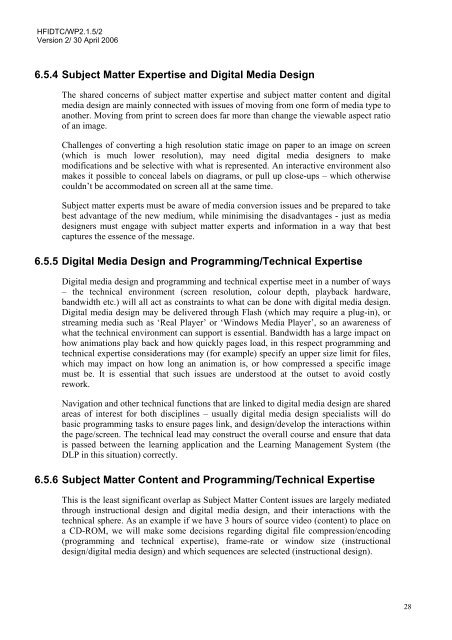E-learning Instructional Design Guidelines - Human Factors ...
E-learning Instructional Design Guidelines - Human Factors ...
E-learning Instructional Design Guidelines - Human Factors ...
You also want an ePaper? Increase the reach of your titles
YUMPU automatically turns print PDFs into web optimized ePapers that Google loves.
HFIDTC/WP2.1.5/2<br />
Version 2/ 30 April 2006<br />
6.5.4 Subject Matter Expertise and Digital Media <strong>Design</strong><br />
The shared concerns of subject matter expertise and subject matter content and digital<br />
media design are mainly connected with issues of moving from one form of media type to<br />
another. Moving from print to screen does far more than change the viewable aspect ratio<br />
of an image.<br />
Challenges of converting a high resolution static image on paper to an image on screen<br />
(which is much lower resolution), may need digital media designers to make<br />
modifications and be selective with what is represented. An interactive environment also<br />
makes it possible to conceal labels on diagrams, or pull up close-ups – which otherwise<br />
couldn’t be accommodated on screen all at the same time.<br />
Subject matter experts must be aware of media conversion issues and be prepared to take<br />
best advantage of the new medium, while minimising the disadvantages - just as media<br />
designers must engage with subject matter experts and information in a way that best<br />
captures the essence of the message.<br />
6.5.5 Digital Media <strong>Design</strong> and Programming/Technical Expertise<br />
Digital media design and programming and technical expertise meet in a number of ways<br />
– the technical environment (screen resolution, colour depth, playback hardware,<br />
bandwidth etc.) will all act as constraints to what can be done with digital media design.<br />
Digital media design may be delivered through Flash (which may require a plug-in), or<br />
streaming media such as ‘Real Player’ or ‘Windows Media Player’, so an awareness of<br />
what the technical environment can support is essential. Bandwidth has a large impact on<br />
how animations play back and how quickly pages load, in this respect programming and<br />
technical expertise considerations may (for example) specify an upper size limit for files,<br />
which may impact on how long an animation is, or how compressed a specific image<br />
must be. It is essential that such issues are understood at the outset to avoid costly<br />
rework.<br />
Navigation and other technical functions that are linked to digital media design are shared<br />
areas of interest for both disciplines – usually digital media design specialists will do<br />
basic programming tasks to ensure pages link, and design/develop the interactions within<br />
the page/screen. The technical lead may construct the overall course and ensure that data<br />
is passed between the <strong>learning</strong> application and the Learning Management System (the<br />
DLP in this situation) correctly.<br />
6.5.6 Subject Matter Content and Programming/Technical Expertise<br />
This is the least significant overlap as Subject Matter Content issues are largely mediated<br />
through instructional design and digital media design, and their interactions with the<br />
technical sphere. As an example if we have 3 hours of source video (content) to place on<br />
a CD-ROM, we will make some decisions regarding digital file compression/encoding<br />
(programming and technical expertise), frame-rate or window size (instructional<br />
design/digital media design) and which sequences are selected (instructional design).<br />
28
















